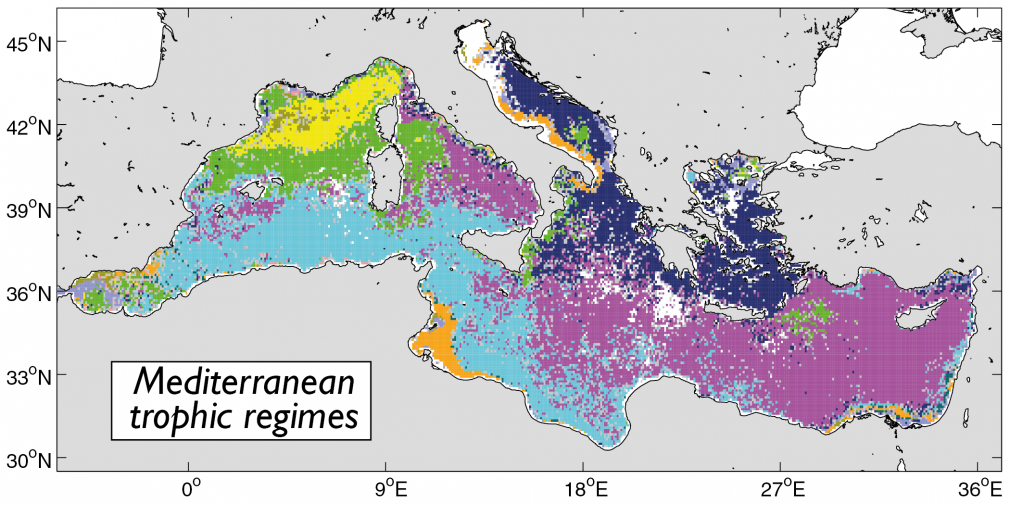ACTUALITES
Soutenance de Thèse de Doctorat de NICOLAS MAYOT au LOV le 16 Décembre 2016
- Lectures : 5599
- Notifications
- Imprimer
- Partager

La saisonnalité du phytoplancton en Mer Méditerranée
LE VENDREDI 16 DECEMBRE 2016 à 09h30 en salle Trégouboff.
Directeurs de Thèse : Fabrizio D'Ortenzio et Hervé Claustre
Composition du Jury :
Marilaure GREGOIRE (rapporteur)
Hubert LOISEL (rapporteur)
Caroline ULSES (examinateur)
Paul NIVAL (examinateur)
Guillaume MAZE (examinateur)
Jean-Michel ANDRE (examinateur)
Fabrizio D'ORTENZIO (Directeur de thèse)
Résumé de la Thèse :
Le phytoplancton est un élément primordial dans les réseaux trophiques marins et il est un acteur principal dans les cycles biogéochimiques de la planète. Cependant, des incertitudes subsistent autour des facteurs environnementaux influençant sa saisonnalité ainsi que sa capacité à se développer (i.e. la production primaire). L'objectif majeur de cette thèse est d'étudier la réponse du phytoplancton à la variabilité interannuelle des facteurs environnementaux en Mer Méditerranée. Plus précisément, il s'agit de déterminer l'influence de ces derniers sur la saisonnalité du phytoplancton, sur sa distribution spatiale, la structuration de sa communauté, et sur sa capacité de production.
Dans un premier temps, la variabilité interannuelle des cycles annuels de biomasses phytoplanctoniques observables en Méditerranée a été analysée. Certaines régions, tel que les zones de formation d'eau dense, présentent une variabilité interannuelle importante. L'une des régions les plus variables est la zone de formation d'eau dense en Méditerranée Nord-Occidentale. Une approche multi-outils basée sur des observations, notamment in situ, a été mise en place pour l'étude des variations spatiale et temporelle de la saisonnalité du phytoplancton dans cette région. Le rôle crucial du mélange vertical et de la disponibilité en lumière sur la saisonnalité du phytoplancton a été évalué. Il est démontré qu'une couche de mélange profonde pendant l'hiver (lié à la convection profonde) augmente l'intensité du bloom phytoplanctonique printanier, due à une présence plus importante dans la communauté phytoplanctonique de micro-phytoplancton (principalement des diatomées). En conséquence, le taux de production primaire printanier augmente, notamment la part de la production phytoplanctonique liée aux diatomées. Enfin, ces modifications de la communauté phytoplanctonique et de la production provoquent, à l'échelle de la région Nord-Ouest, une augmentation du stock de carbone organique produit au printemps.
Abstract :
The phytoplankton are essential for the oceanic trophic webs and for biogeochemical cycles on Earth. However, uncertainties remain about the environmental factors influencing its seasonality, and its growing efficiency (i.e. primary production). The main objective of this thesis is to characterize the responses of the phytoplankton to the interannual variability of the environmental factors, in the Mediterranean Sea. More precisely, we aim to assess the influence of the environmental factors on phytoplankton seasonality, its spatial distribution, and the associated community structure and rates of primary production.
The interannual variability of the phytoplankton annual cycles are analyzed in the Mediterranean Sea, thus highlighting the regions associated with annual cycle variability, like the ones where deep-water formation events occur recurrently. One of these regions is the North-Western Mediterranean Sea. A multiplatform approach based on in situ observations is implemented to analyze the spatial and temporal variability of the phytoplankton seasonality in this particular region. The influences of mixed layer depth and the light availability on phytoplankton seasonality are assessed. An intense deepening of the mixed layer (related to the deep convection) increases the magnitude of the phytoplankton spring bloom. Moreover, the strong deepening of mixed layer seems to induce favorable conditions for an important accumulation of micro-phytoplankton (composed of diatoms mainly). In turn, the phytoplankton production rate increases, mostly, the primary production rate of diatoms. Finally, at the scale of the North-Western Mediterranean Sea, the shift in the phytoplankton community structure and in production induces an increase of the organic carbon stock produced during spring.
Modifié le
SUIVEZ NOTRE FIL TWITTER
L'OBSERVATOIRE
L'OBSERVATION
- Variables
- Stations d'observation
- Plateformes
- Services d'observation
- Organigramme
- Données d'observation
RESSOURCES
